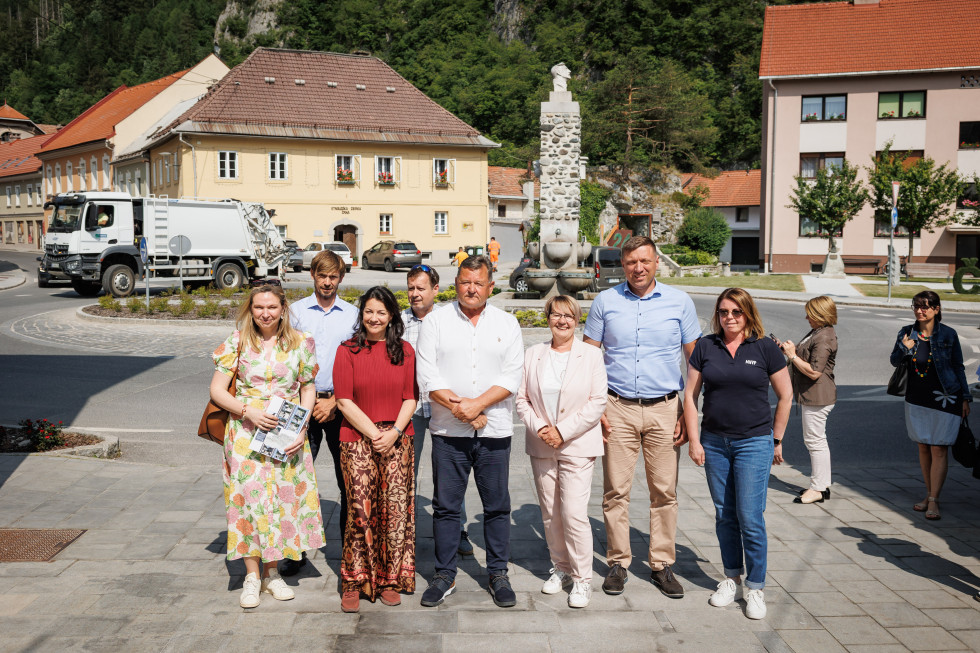As much as 88% of financial assistance from the EU Solidarity Fund already used for post-flood recovery

Minister Dr Aleksander Jevšek, State Secretary Srečko Đurov, State Secretary Dr Lidija Kegljevič Zagorc, State Secretary mag. Andrej Rajh, and European Commission delegation in Črna na Koroškem | Author Nebojša Tejić/STA
‘’Slovenia received over 428 million euros from the EU Solidarity Fund for post-flood recovery. This funding complements the funding set aside for post-disaster recovery by the state. We have already spent as much as 88% of total EU Solidarity Fund aid, that is, over 376 million euros. I’m positive we’ll make further smart investments by 8 June 2026 and make every euro count. About 50 million euros from the EU Solidarity Fund has already been used for post-recovery and reconstruction projects in the region of Koroška,’’ said the Minister for Cohesion and Regional Development, Dr Aleksander Jevšek.
Črna na Koroškem today looks completely different than nearly two years ago. All the credit for this goes to its residents and the entire local community. After being severely hit by the floods, the community came together, joining forces with people from other parts of the country, Slovenian authorities, and the EU through Solidarity Fund to rebuild. ‘’We have come far but we still have some way to go as new challenges always come up. Still, I am sure that the post-flood reconstruction will be of high quality and completed relatively quickly,’’ added Minister Jevšek.
‘’Črna na Koroškem was one of municipalities hardest hit in Slovenia by the August 2023 floods. After visiting these places today together with the representatives of the European Commission, we see with our own eyes how much effort has actually been put into restoration and recovery. Črna na Koroškem today is worlds apart from the Črna na Koroškem immediately after the floods. All the main works to ensure stability, resilience, and river flow have been carried out. But there is still some work ahead of us to ensure that the reconstruction is fully completed,’’ said the State Secretary at the Ministry of Natural Resources and Spatial Planning, Dr Lidija Kegljevič Zagorc.
The State Secretary at the Ministry of Infrastructure, mag. Andrej Rajh, said during the field visit: »The images of the devastation caused in early August 2023 left an imprint in our mind. At the time, our main goal was to get all damaged roads passable again as soon as possible in all affected areas. Together with the contractors we worked hard to repair and reopen traffic infrastructure and restore community connectivity. I am glad that we also managed to repair and upgrade the heavily damaged Poljana-Šentvid road, which is now much more resilient and will be able to withstand extreme weather.’’
Sofia Alves from the European Commission’s Directorate-General for Regional and Urban Policy (DG REGIO) commended the quality and speed of the reconstruction work, stressing that this would not have been possible without the cooperation of the European Commission, the ministries and the local community.
On this occasion, the Mayor of Črna na Koroškem, Ms Romana Lesjak, thanked the European Commission and Slovenian authorities for the rapid assistance to Slovenia, Črna na Koroškem and the entire region. Ms Lesjak took the delegation to several construction sites and to a photo exhibition with striking ‘’then’’ images showing the devastating effects of August 2023 floods and ‘’now’’ images.
EU Solidarity Fund helped finance:
- water and wastewater measures (restoration of essential water infrastructure in different river basins),
- transport measures (rehabilitation of riverbanks, reconstruction of bridges and roads, remediation and stabilization of landslides, reconstruction of public rail infrastructure),
- costs of emergency operations to meet immediate needs of the affected population (collection of unsorted waste),
- collection of debris and waste resulting from the landslides and mudslides caused by the floods,
- removal of contaminated soil, and
- reimbursement of salaries for clean-up work.
Slovenia will prepare the final implementation report by the end of 2026.

